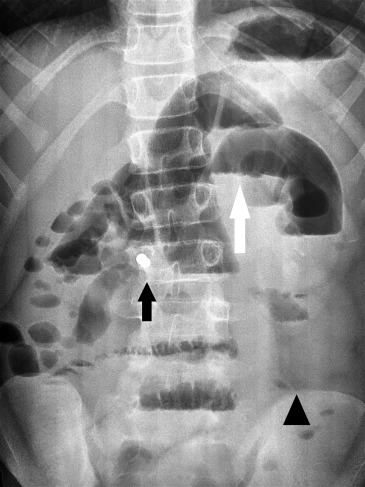A 9-year-old previously healthy boy presented with 5 days of low-grade fever, bilious emesis, and intermittent abdominal pain. He was initially admitted for suspected gastroenteritis and treated with intravenous fluids. He clinically deteriorated the following day, with worsening emesis, decreased bowel movements, abdominal distention, and increased inflammatory markers. Eventually, his mother reported that he had recently ingested 2 magnetic pieces from a table board game, but the objects were never noted in subsequent stools. Abdominal radiography revealed the cause of his obstructive ileus ( Figure ).

Diagnosis
Jejunoileal fistula and jejunum perforation from swallowed magnets . Emergency laparotomy revealed 2 small magnets (1.5×2 cm) that had attached to each other, causing a bowel perforation. The magnets were removed and the perforated midsmall bowel was resected with primary anastomosis. He had an uneventful postoperative recovery course and was discharged 10 days later.
Two or more magnets separated from one another within bowel can attract through the intestinal walls, resulting in pressure necrosis, bowel perforations, and fistulas formation, leading to generalized peritonitis and shock. Radiography may not be able to distinguish whether swallowed magnetic objects are separated or engaged. The history might be difficult to obtain, leading to delays in presentation and to diagnostic dilemmas. Recently, the reported incidence of pediatric swallowed magnetic foreign bodies has increased. Safety regulations have been published for public and physician awareness, and algorithms have been developed to assist prompt clinical decisionmaking. Multiple ingested magnetic foreign bodies typically should be removed urgently, regardless of symptoms, to prevent intestinal injury.
For further discussion on this case, see page 516.
For the diagnosis and teaching points, see page 529.
To view the entire collection of Images in Emergency Medicine, visit www.annemergmed.com .

Full access? Get Clinical Tree




